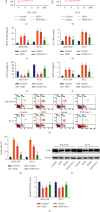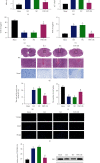miR-672-3p Promotes Functional Recovery in Rats with Contusive Spinal Cord Injury by Inhibiting Ferroptosis Suppressor Protein 1
- PMID: 35237382
- PMCID: PMC8885177
- DOI: 10.1155/2022/6041612
miR-672-3p Promotes Functional Recovery in Rats with Contusive Spinal Cord Injury by Inhibiting Ferroptosis Suppressor Protein 1
Abstract
Aberrantly expressed microRNAs (miRNAs) after spinal cord injury (SCI) participate in diverse biological pathways and processes, including apoptosis, inflammation, oxidative stress responses, peroxidation, and ferroptosis. This study was aimed at exploring the mechanisms underlying miRNA-mediated ferroptosis in an SCI rat model. In the present study, a T10 weight-dropping SCI model was established and miRNA profiling was used to detect miRNA expression profiles post-SCI. Basso-Beattie-Bresnahan scores and inclined plane test, hematoxylin and eosin (HE) and Nissl staining, immunohistochemistry and immunofluorescence, western blotting, cell viability, and Annexin V/7-aminoactinomycin D (7-AAD) assays were used to evaluate locomotor activity, histological changes in the injured spinal cords, neuronal ferroptosis, ferroptosis suppressor protein 1 (FSP1) expression, and cell death, respectively. It was observed that many miRNAs were differentially expressed after SCI, and miR-672-3p, which increased significantly, was selected after cross-referencing with predicted target miRNAs. The luciferase reporter assay demonstrated that miR-672-3p downregulated FSP1, a glutathione-independent ferroptosis suppressor, by binding to its 3' untranslated region. Oxygen and glucose deprivation- (OGD-) treated PC12 and AGE1.HN cells were treated with miR-672-3p mimics or inhibitors in vitro. The effect of miR-672-3p mimics or inhibitor on OGD-PC12/AGE1.HN ferroptosis was evaluated by flow cytometry, immunohistochemistry, immunofluorescence, and western blotting. The miR-672-3p mimics promoted ferroptosis after SCI, whereas the miR-672-3p inhibitor inhibited this process. Rats with SCI treated with miR-672-3p mimics or inhibitor showed similar results in vivo. Furthermore, the ferroptosis-related changes caused by SCI or miR-672-3p were reversed by overexpression of FSP1 lentivirus in vivo and in vitro. These results indicated that sh-miR-672-3p exerted a neural restoration effect in vivo and in vitro by inhibiting ferroptosis via the FSP1 pathway.
Copyright © 2022 Fang Wang et al.
Conflict of interest statement
The authors declare that there is no conflict of interest regarding the publication of this paper.
Figures







Similar articles
-
MiR-212-3p improves rat functional recovery and inhibits neurocyte apoptosis in spinal cord injury models via PTEN downregulation-mediated activation of AKT/mTOR pathway.Brain Res. 2021 Oct 1;1768:147576. doi: 10.1016/j.brainres.2021.147576. Epub 2021 Jul 1. Brain Res. 2021. PMID: 34216580
-
Bone marrow mesenchymal stem cells modulate miR-202-3p to suppress neuronal apoptosis following spinal cord injury through autophagy activation via the AMPK, MAPK, and PI3K/AKT/mTOR signaling pathway.Sci Rep. 2024 Dec 3;14(1):30099. doi: 10.1038/s41598-024-81332-y. Sci Rep. 2024. PMID: 39627300 Free PMC article.
-
MiR-543-3p promotes locomotor function recovery after spinal cord injury by inhibiting the expression of tumor necrosis factor superfamily member 15 in rats.Eur Rev Med Pharmacol Sci. 2019 Apr;23(7):2701-2709. doi: 10.26355/eurrev_201904_17540. Eur Rev Med Pharmacol Sci. 2019. PMID: 31002119
-
Ferroptosis: A Novel Therapeutic Direction of Spinal Cord Injury.Comput Math Methods Med. 2022 Jul 12;2022:7906218. doi: 10.1155/2022/7906218. eCollection 2022. Comput Math Methods Med. 2022. Retraction in: Comput Math Methods Med. 2023 Jul 12;2023:9863854. doi: 10.1155/2023/9863854. PMID: 35866036 Free PMC article. Retracted. Review.
-
The key role of Piezo1 channels in ferroptosis after spinal cord injury and the therapeutic potential of Piezo1 inhibitors.Prog Biophys Mol Biol. 2025 Jun;196:132-140. doi: 10.1016/j.pbiomolbio.2025.05.001. Epub 2025 May 6. Prog Biophys Mol Biol. 2025. PMID: 40339662 Review.
Cited by
-
Epigenetic Regulation of Ferroptosis in Central Nervous System Diseases.Mol Neurobiol. 2023 Jul;60(7):3584-3599. doi: 10.1007/s12035-023-03267-1. Epub 2023 Feb 27. Mol Neurobiol. 2023. PMID: 36847936 Review.
-
Ferroptosis and Its Role in Chronic Diseases.Cells. 2022 Jun 27;11(13):2040. doi: 10.3390/cells11132040. Cells. 2022. PMID: 35805124 Free PMC article. Review.
-
Bone Marrow Mesenchymal Stem Cell-Derived Exosomes Promote the Recovery of Spinal Cord Injury and Inhibit Ferroptosis by Inactivating IL-17 Pathway.J Mol Neurosci. 2024 Mar 27;74(2):33. doi: 10.1007/s12031-024-02209-3. J Mol Neurosci. 2024. PMID: 38536541
-
Identification of Differentially Expressed microRNAs Associated with Ischemic Stroke by Integrated Bioinformatics Approaches.Int J Genomics. 2022 Oct 10;2022:9264555. doi: 10.1155/2022/9264555. eCollection 2022. Int J Genomics. 2022. PMID: 36262825 Free PMC article.
-
Ferroptosis in heart failure.J Mol Cell Cardiol. 2022 Dec;173:141-153. doi: 10.1016/j.yjmcc.2022.10.004. Epub 2022 Oct 20. J Mol Cell Cardiol. 2022. PMID: 36273661 Free PMC article. Review.
References
MeSH terms
Substances
LinkOut - more resources
Full Text Sources
Medical
Research Materials

